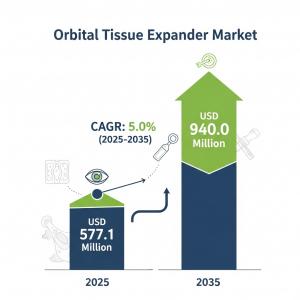Orbital Tissue Expander Market Growth Manufacturers Positioned to Seize USD 940 Million Opportunity by 2035
Advanced devices, rising demand for minimally invasive care, and expanding access to reconstructive ophthalmology are fueling global market growth.
NEW YORK, DE, UNITED STATES, August 14, 2025 /EINPresswire.com/ -- The Orbital Tissue Expander Market, currently valued at USD 577.1 million in 2025, is on track to reach USD 940.0 million by 2035, reflecting a steady 5.0% CAGR. This trajectory is driven by rapid advancements in material science, patient-centered care models, and an increased global awareness of functional and aesthetic orbital rehabilitation. For manufacturers, this upward momentum represents not just a market expansion—but a transformative shift in how orbital reconstruction is approached worldwide.
Oculoplastic procedures are becoming increasingly sophisticated, with both patients and surgeons seeking solutions that minimize intervention while maximizing results. From treating congenital deficiencies to managing post-trauma reconstruction, orbital tissue expanders are emerging as the preferred alternative to traditional acrylic implants, offering improved safety profiles, reduced surgical adjustments, and faster recovery times.
Why Manufacturers Hold the Key to Market Evolution
Hydrophilic osmotic hydrogel devices—poised to capture 58.3% of market share in 2025—are leading this shift. Their self-inflating properties reduce the need for repeat surgeries, while their biocompatibility ensures better patient comfort and lower infection risks. This is particularly relevant for pediatric patients, where gradual, controlled expansion is essential for anatomical restoration without unnecessary trauma.
For manufacturers, the demand curve is clear: innovation that balances clinical precision with procedural simplicity will dominate. Hospitals, which account for nearly half of global distribution revenue (46.7% in 2025), are reinforcing this trend by adopting devices that integrate seamlessly into surgical workflows, backed by advanced imaging and multidisciplinary care capabilities.
Click Here for More Information:- https://www.futuremarketinsights.com/reports/orbital-tissue-expander-market
Unlocking Opportunities Across Regions
North America remains the most lucrative region, benefiting from high awareness levels, sophisticated surgical infrastructure, and favorable insurance coverage. Europe continues to make significant contributions, driven by widespread adoption of minimally invasive solutions and strong healthcare systems.
Asia-Pacific, however, is where future growth acceleration is expected to peak. Increasing government participation, infrastructure investment, and training programs are expanding patient access to specialized orbital reconstruction. For manufacturers, this signals the importance of strategic regional entry, ensuring product availability and localized education to overcome historical limitations in emerging markets.
Latin America and the Middle East & Africa are anticipated to grow at a more modest pace due to limited public awareness and uneven healthcare access. Yet, these regions also represent untapped potential, particularly as technology transfer, partnerships, and international funding initiatives begin to close existing care gaps.
Technological Innovation as a Growth Multiplier
The global market’s expansion is not solely volume-driven—it’s being reshaped by technological integration. Manufacturers developing devices with biologically responsive materials, enhanced precision controls, and reduced patient trauma are setting the competitive pace. The long-term opportunity lies in designs that merge predictable expansion mechanics with the adaptability required for diverse clinical needs.
Minimally invasive procedures are no longer a secondary consideration—they are now the industry standard. The reduced risk of conjunctival trauma, coupled with the elimination of pressure points during expansion, represents a clear advantage over older surgical methods. For manufacturers, this means prioritizing product pipelines that anticipate both surgeon preferences and patient comfort expectations.
Addressing Market Restraints with Strategic Solutions
While the market outlook is promising, growth is tempered by challenges, particularly the limited availability of orbital tissue expanders in developing countries. Manufacturers that invest in supply chain expansion, training for specialized surgeons, and localized distribution networks will be best positioned to capture unmet demand. Cost-effectiveness remains a competitive edge, but the true differentiator will be ease of adoption across healthcare systems with varying levels of surgical sophistication.
Get Sample Report: - https://www.futuremarketinsights.com/reports/sample/rep-gb-2045
Future Outlook: From Niche Device to Standard of Care
Once primarily seen as a solution for rare pediatric conditions such as anophthalmia and microphthalmia—which account for around 11% of childhood blindness—orbital tissue expanders are now recognized for their broader reconstructive potential. Trauma cases, tumor resections, and other orbital volume loss conditions are driving adoption well beyond the original scope.
Between 2025 and 2035, the market will benefit from both increased early diagnosis rates and rising patient willingness to pursue reconstructive care. This evolution positions the orbital tissue expander not as a specialized product, but as an integral component of modern ophthalmic surgery.
For manufacturers, the call to action is clear: respond to the shift toward minimally invasive, patient-centered solutions; leverage material science advancements; and strategically expand market reach to regions where need is highest. Those who adapt will not only capture a share of the USD 940 million market but will also play a defining role in the future of orbital reconstruction.
Editor’s Note:
This release is based entirely on provided market data and analysis. No external sources were used.
Discover Related Research:-
Antimicrobial Wound Care Dressings Market
https://www.futuremarketinsights.com/reports/antimicrobial-wound-care-dressings-market
Ureterorenoscopes Market
https://www.futuremarketinsights.com/reports/ureterorenoscopes-market
Dermal Fillers and Botulinum Toxin Market
https://www.futuremarketinsights.com/reports/dermal-fillers-and-botulinum-toxin-market
Rahul Singh
Future Market Insights Inc.
+1 347-918-3531
email us here
Legal Disclaimer:
EIN Presswire provides this news content "as is" without warranty of any kind. We do not accept any responsibility or liability for the accuracy, content, images, videos, licenses, completeness, legality, or reliability of the information contained in this article. If you have any complaints or copyright issues related to this article, kindly contact the author above.

